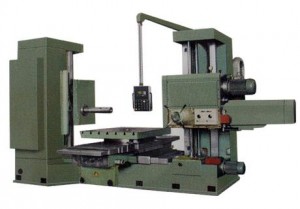Drilling Machines

Drilling is considered by many to be the fastest and most economical metal-cutting or machining process. A small drill press which will take /2-in. diameter drills is a popular and inexpensive machine for drilling, reaming, lapping, tapping, spot-facing, or counter-boring small holes. Holes as large as 3 in. in diameter are drilled on larger machines. The radial drill press is a very useful heavy-duty machine which has a drill head mounted on a movable arm that travels to the position desired for drilling operations. Because of this maneuverability, the work may be clamped on a stationary table while holes are drilled at various points. Mold plates often require many parallel holes for the circulation of heating or cooling media.
For deep hole drilling, a gun drill is normally used to assure a straight and true hole. A straight hole becomes essential when a drilled hole may be only 1/3 to Vs in. away from a mold pocket 20 in. or more from the edge of the plate where the drilled hole started. A gun drill (sometimes called spade drill) has cutting edges at the tip, and relieved spiral flutes. A small hole for cooling and flushing exists through each Lip of the drill. Special gun drilling machines have several drilling heads, adjustable for spacing, and operate very much in the same manner as a horizontal boring mill.
Lathes

The lathe is the most common piece of tool room equipment. standard tool room lathes range from the small bench models to large engine lathes. Lathes are used for cutting round shapes and internal and external threads, and for boring, grinding, polishing, etc.. The small bench lathe is a high-speed tool used largely for producing the small round pins used in mold making. Some tool shops have high speed polishing lathes, but the average shop uses a high-speed bench lathe for this work.
Copying or tracing lathes can be used for cutting complex profiles in a cavity or on a core. They have tracing heads which will follow the profile of a template or pattern fixed firmly to the lathe bed. By electric or hydraulic means, the tracing stylus controls the motion of the lathe tool which then duplicates the geometry of the pattern on the work piece. Equipment of this type can save many hours of calculation in design or fabrication in the shop. It greatly reduces the possibility of error or variation from part to part on a number of duplicate mold parts.
Some shops now have tape operated lathes which have ductility of the mold maker even further. A tape operate program punched into a paper tape. Once a work piece is on e chucking device, the tape automatically machines the piece in ^co the punched program. Obviously, a machine running automatic can produce a finished piece much more quickly than an operator who as to con continually adjust and set the machine. Some molds may require 1 or cavities and forces of a cylindrical nature, and this dictates a tape control a machine for cost savings, as well as shortened delivery time.
Jig Borer

A jig borer is a combination of drill press and vertical mill, and is capable of very precise work. The movable work table has adjusting feeds which permit the locating and spacing of holes with extreme accuracy. Dial indicators may be used for measuring distances to 0.0001 in. Holes may be located and drilled accurately and reamed or bored to size in this machine. The advantage gained by the use of a jig borer derives from its ease in locating any number of holes with extreme accuracy. Odd sizes of holes may be bored to the correct size easily in this machine. Jig borers are especially helpful for layout work which demands precision.
